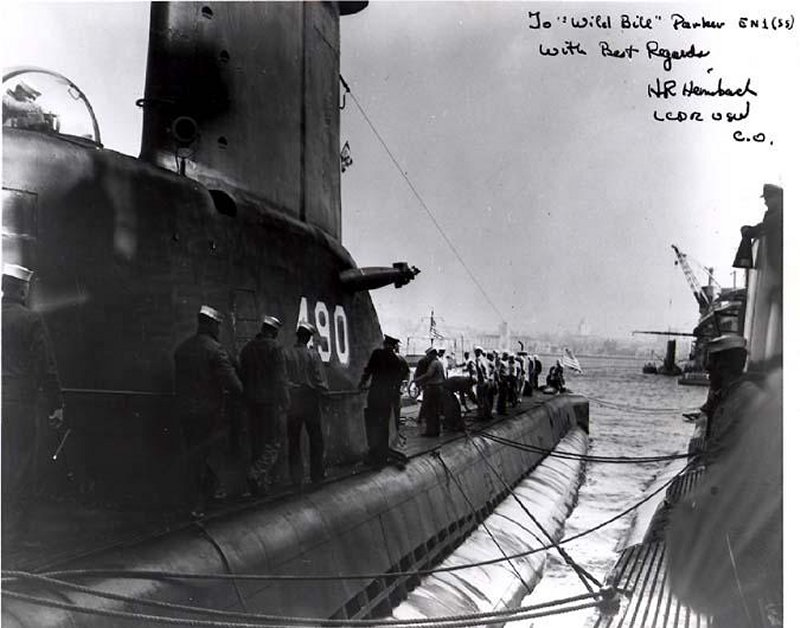It sounds like control of the vessel was lost as a result. ... Looking at the video the sub appeared under perfect control at moderate speed for at least 10 seconds after the pop when filming ended. Did things go crazy after that
? :confused2: Can you explain the mechanism?

larry

Firstly, we have a 1570-ton Tench class submarine that is sticking a good portion of said tonnage from the heavy medium of seawater into the lighter medium of air. At the peak of the upward lunge, the boat is blowing ballasts and maximum powering up from 150 feet, exceeding the surface by maybe 60 feet, and maybe as much as 300 tons less seawater is being displaced. No longer displacing all that seawater, at that moment, that boat would be as much as that, negatively buoyant. The boat is about 300 feet long, its test depth is something like 407 feet. When the boat starts back down backwards, pushed by all that weight, how deep will the After Torpedo Room be? Those old boats had many systems connected to seawater through hull valves. These valves normally remain open at 150 feet. Beyond 200 feet depth on this class of boat, a condition known as, "Deep Submergence," is set, requiring the shutting of all the hull valves on systems not designed for the heightened pressures.
Now, I for one was on a boat just like the Pickerel, and I and my 80 companions also experienced losing the bubble, but in our case, it was a fast dive drill, during which an AC power system failed, resulting in loss of hydraulic power to the bow and stern planes, among other things. We took a 37 degree down angle with "all ahead, flank speed" the last order to the Maneuvering Room. Our bow exceeded test depth before we came back into level running, amidst plumbing failures throughout the boat, as we never had the time to "rig for Deep." Coming back up, we well exceeded 30 degrees up angle, as the forward main ballasts had been blown on the way down.
All the mess of various benches, loose gear, and exploded Pyrex coffee cups, piled up at the front ends of the various compartments then went crashing aft. In the Control Room at the time, the main hydraulic supply tank was in the process of being topped off and several 5 gallon cans of hydraulic oil were sitting open and ready to pour. These overturned and added a nice touch to the mess. We never tried a drill anything like that again. And I believe there is nothing much in the
ship's log to say it ever happened, though the crew was busy for two full days, cleaning up the mess.
I wasn't on the Pickerel that day, and I'm glad of that. I would have been scared sh*tless. In our case, we had a good young skipper who had recently taken command and his boat was fresh out of a shipyard refit. He wanted to put it through its paces. He learned something that day, and I believe that after that sobering experience, he rigged in his planes just a bit. I was only in about my third week of submarine duty without even the benefit of Sub School. I was mostly ignorant of the danger I had been in. After another two years of serious emergencies, I had been converted. I don't think those old diesel boats were a safe place to be. I became one of those who thinks, when your number's up, your number's up. I rode motorcycles for years after I got out, and I still believe that. Too many close calls in my lifetime. A tractor up on two wheels seems pretty mild in my old age. Still gets the blood flowing, though.
===============
On edit: Looking again at the pictures of Pickerel, I see that there is still rise on the bow planes. I can only assume there is still rise on the stern planes (with power still maxed at the screws, this is pretty much the equivalent of pulling from above the rear axle). I understand at this moment, there is no longer any deck under the planesmen, and they can exert no effort to change this, even if ordered. Nobody in the crew has a place to stand at this moment, except maybe on a rear compartment bulkhead. They are not strapped into bucket seats at control consoles. I can only think that just about everyone in that crew knows that things are not quite right at that moment, but can see little they can do about it. The full rise on the bow and stern planes will slowly help them level off as they are backing down into Davey Jones' Locker and the deep six. They were a lucky bunch of guys that day.




